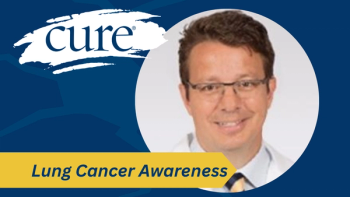
Brain Cancer Awareness Month Highlights Advances in Radiation Therapy
Key Takeaways
- Proton therapy and image-guided precision have improved outcomes for primary brain tumor patients by minimizing toxicity and enhancing targeting accuracy.
- Multidisciplinary collaboration, involving neurosurgeons, radiation oncologists, and other specialists, is crucial for individualized, evidence-based brain cancer care.
Dr. Ranjit S. Bindra discusses recent advancements for the treatment of patients with primary brain tumors during Brain Cancer Awareness Month.
Recent advancements like proton therapy, radiosurgery and image-guided precision, have elicited more personalized care and better outcomes for patients with primary brain tumors, according to Dr. Ranjit S. Bindra, who added that despite these advancements, there is still more work to be done.
“We know that the support of both government-funded research and foundation-funded research will be essential for us to make progress; we cannot do it without that. As long as we maintain that funding, we will continue to make wonderful discoveries and change the lives of patients with brain cancer,” Bindra, the Harvey and Kate Cushing professor of therapeutic radiology and professor of pathology, at Yale School of Medicine, emphasized in an interview with CURE.
During the discussion, he spoke about recent advancements for the treatment of patients with primary brain tumors, factors that influence treatment decision-making, as well as the importance of multidisciplinary collaboration during care.
Bindra also serves as the vice chair for Translational Research, Therapeutic Radiology and scientific director of the Chênevert Family Brain Tumor Center at Smilow Cancer Hospital and Yale Cancer Center. He is also the chief of Pediatrics Central Nervous System Radiotherapy Program, therapeutic radiology and chief of the Central Nervous System Radiotherapy Program, therapeutic radiology.
CURE: What are some recent significant advancements in therapeutic radiology for patients with primary brain tumors or brain metastases?
Bindra: I think it’s an exciting time for the field of radiation oncology because we are now showing that novel, advanced treatment modalities like proton-based radiotherapy and even carbon therapy are showing significant benefits, promise, and potential. [These modalities] are really the next generation of radiation therapy for patients.
These treatments, especially protons, offer precise targeting with minimal toxicity to the normal tissue, or sparing of the normal tissue. From a radiation oncology perspective, we’re getting much better at localizing and treating these tumors while sparing the normal tissue. That’s for primary brain tumors, but also for brain metastases.
For patients who have developed these brain metastases, we are also now able to use a technique called radiosurgery and really pinpoint precise radiation to those spots in the brain, potentially [avoiding] surgery or toxic systemic therapy options.
How has the integration of image-guided radiotherapy, such as stereotactic radiosurgery or proton therapy, impacted treatment precision and outcomes in brain cancer care?
With the technology developments, we're able to perform what we call IGRT, or image-guided radiation therapy, pretty effectively and quickly. Onboard technology, including what we call KV images, which are essentially high-quality X-rays or two-dimensional X-rays, and also cone-beam CT scans that are integrated into the instrument, allows us to do extensive imaging of the patient. This enables us to rapidly align them and really achieve millimeter to sub-millimeter accuracy.
So, advancements in image guidance, in terms of both the speed and the quality of the imaging, are allowing us to use these techniques and integrate them into our general practice, which has been great for patients.
What factors influence your decision-making when selecting between conventional radiation, stereotactic techniques, or emerging modalities for brain tumor treatment?
A lot of the consideration when we think about proton-based therapy over conventional radiation involves the timeline of late effects, for instance. So, if we have a five-year-old patient with a tumor that's expected to be controlled for 40 to 50 years or ultimately cured with radiation therapy, we really want to minimize the dose to the normal tissue, because there's a much longer period during which second cancers can arise, or late effects [can manifest].
In certain patients where we unfortunately don't have a good prognosis, and their life expectancy is on the order of years, we tend to stick with the more conventional radiation therapy options. Those have probably been the most important factors. But then, on top of all that, is the availability of machines.
Traditionally, there have been some areas where proton-based radiation therapy would require the patient to travel extensively. However, now in New England, for instance, with proton therapy being established in Connecticut within the next year and a half, patients will now have options between New York, Boston, and Connecticut to receive their treatment.
As brain cancer treatments evolve, how do you approach multidisciplinary collaboration to ensure patients receive individualized, evidence-based care that includes radiologic interventions?
The real heart of everything is the multidisciplinary management of tumors. I think most major centers now have multidisciplinary tumor boards where it's very important to have a neurosurgeon, a radiation oncologist, a neuro-oncologist, a radiologist, and a pathologist, typically, as the core team. Having everyone look at the case together allows for a balanced discussion on whether surgery is appropriate, what the role of radiation should be, whether systemic therapy is indicated, and if a combination of therapies is the best approach.
I think in this day and age, we now recognize that having all voices at the table with the common goal of minimizing toxicity for the patient while maximizing efficacy and really optimizing the risk-benefit ratio for the recommended therapy is critical. In the past, we've had people working in silos, leading to many arguments in the field between different modalities on what should be used.
[At this time], everyone is reaching across the table to say, "Well, maybe we could spare this patient, and conventional dogma here doesn't have to apply." So, I think overall, this multidisciplinary tumor board approach and collaboration across specialties has been critical.
What is the importance of recognizing Brain Cancer Awareness Month?
I think it's important to realize that while a lot of folks say, "Well, these are rare cancers," even a single case of a glioblastoma rather, in an adult or a child can devastate a community, especially in the younger population. So, even if we have 15,000 cases of glioblastoma every year, and that may be much less common than other cancers outside of the brain, we need to have better therapies. Right now, we are really in desperate need of new treatments.
I think the excitement of this month [is that it] always reminds us to look back at the last year, and we've had a number of major pharma biotech deals, suggesting that there's an interest in developing therapeutics by groups that might not have been as excited. There are [many] companies out there like Day One Therapeutics, Jazz Pharmaceuticals' acquisition of Chimerix for the ONC201 drug being developed for brain cancers, and our own company that we spun out, Modifi Bio, which was sold to Merck and is developing a novel drug for GBM, and obviously Angios and Servier working together for IDH inhibitors.
What is your main takeaway for patients based on this topic?
I think when you look back at where we were in the last year, it's important to remember that we are just getting started with novel therapeutics development. There are going to be a lot of options in the future for patients.
All we can say is that there is hope, and we are only learning more. We know that the support of both government-funded research and foundation-funded research will be essential for us to make progress; we cannot do it without that. As long as we maintain that funding, we will continue to make wonderful discoveries and change the lives of patients with brain cancer.
Transcript has been edited for clarity and conciseness.
For more news on cancer updates, research and education, don’t forget to





